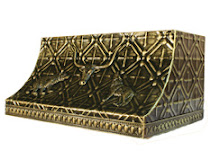
Metal Artist and Designer Tanya Kocinski calls this Heavy Sleeper and you can find this and more on her website.
for everyone who appreciates the value, beauty, function and history of tin

The Virtual Absinthe Museum is an interesting place indeed, offering history, literature, art and antiques all about - you guessed it - Absinthe.

From sugar shakers and spoons to herbs, ingredients and recipes, you'll find it here. A special treat for art lovers is the homage to Picasso, Absinthiana II - The Genesis of Picasso's Verre d'absinthe?...

however I am fondest of the Absinthe Chromolithographs on Tin.
Metallo Arts has been releasing some pretty cool vidz this season (they have their own channel on YouTube) but I'm not sure if Another Jackson Pollock Range Hood is my favourite because I like to see how Plummer makes his pieces, or if it's the awsome music chosen for the video...
Artist Bobby Hansson has worked in photography and in television, but today, he works exclusively in the tin can medium. Hansson creates music and art from tin cans and even wrote a book about it. Independent producers Ann Heppermann and Kara Oehler speak with Hansson from his farm in Rising Sun, Md., about the allure of tin cans his life as an artist. Listen to Bobby's story...




A glaze containing tin oxide is applied to dark-coloured earthenware bodies to produce an opaque white surface, in imitation of porcelain. The glaze can subsequently be decorated with metal oxide pigments. In Europe this technique had originated in Islamic Spain; it had spread to Italy by the fifteenth century and throughout the northern countries by the late sixteenth century. It is known variously as maiolica, faience or Delftware according to the country of origin.

 lovely tin type online
lovely tin type online


 Tin victorian style 3-d heart, painted black with red & gold. About 5". can be hung on tree or wall. Write your names or saying on the banner.
Tin victorian style 3-d heart, painted black with red & gold. About 5". can be hung on tree or wall. Write your names or saying on the banner.
Sheldon Gruber is president of Aa-Abbingdon Affiliates Inc., Brooklyn, N.Y. He is third generation in the tin ceilings business, and his company offers 42 ceiling patterns and 18 molding patterns in its Prestplate Metal Ceilings line. Two years ago, the company launched something new: hand-painted tin panels. “The quality is extremely high,” said Gruber, who added that his finishes are not powder coated or “faux,” but realistic renditions created by artists. “We should have the artist sign each panel–they’re that special,” he said. At $95 a 2 x 4-foot sheet, the price seems high, but Gruber said the hand-painted line is drawing a lot of customer attention.
 Historically, tin ceilings were introduced to North America as an affordable alternative to the exquisite plasterwork used in European homes.
Historically, tin ceilings were introduced to North America as an affordable alternative to the exquisite plasterwork used in European homes.Sheets of tin were stamped one at a time using rope drop hammers and cast iron molds. Using this method of production, metal was sandwiched between two interlocking tools. The top tool, or "ram," was lifted up by a rope or chain then dropped down onto the bottom die, smashing into the metal that was underneath. This process of repeatedly hammering the metal would permanently embed intricate patterns into the tin.
Tin ceilings were traditionally painted white, giving the appearance of hand-carved or molded plaster. They were incorporated into residential living rooms and parlors as well as commercial businesses, where painted tin was often used as wainscoting.
In the 1930's tin ceilings began to lose their popularity and ceilings, and as a result were ignored as a design element. As a result, few companies continued to produce pressed metal panels. Anyone hoping to have a tin ceiling was relegated to using salvage pieces from old buildings, an imperfect and time consuming undertaking.



